Jonathan Clauss (178cm/5’10”, 67kg/147lbs) was Lens’ most prolific assist-provider in Ligue 1 last season, with 10 of his team’s 62 goals (16.13%) being assisted by the right wing-back.
Clauss had been the subject of a great deal of summer transfer speculation in recent weeks, with the likes of EPL sides Chelsea and Manchester United getting linked with respective transfer moves for the 29-year-old (who’ll be 30 in September). However, Clauss will remain in Ligue 1, with Marseille having now completed the Frenchman’s signing for a reported €7.5m fee.
This could be a big loss for Lens. However, there is hope for Les Sang et Or, who secured the signature of a Clauss replacement earlier this summer in the form of 28-year-old Jimmy Cabot (164cm/5’4”, 64kg/141lbs), who joins from fellow Ligue 1 competitors Angers for a reported €2m.
Cabot also primarily played at right wing-back for his club last season and, similar to Clauss, he ended 2021/22 as his team’s top Ligue 1 assist provider from that position, with five league assists to his name (11.36% of his team’s 44 goals — not bad considering Cabot missed his team’s last 13 league games through injury).
Clauss impressively managed 0.28 assists per 90 in the league last term but Cabot’s 0.21 assists per 90 are nothing to scoff at and highlight his significant level of threat from the right-wing in a three-centre-back system at Angers, similar to the system of Lens.
With all of this in mind, today’s tactical analysis and scout report aims to look at how Lens intend to replace Clauss with Cabot in their starting eleven. We’ll recap what exactly Clauss’ role within the team’s tactics was and what qualities the 29-year-old brought to the table before moving on to provide an analysis of Cabot and what he has to offer his new team from right wing-back.
The wing-back role at Lens / Clauss’ qualities
Lens’ wing-backs carry a lot of responsibility within their tactical system, which varied a lot last season from their usual 3-4-1-2 system to 3-4-2-1, 3-4-3 and 3-5-2 at times. We’ve written extensively about Lens and Clauss in the past here at Total Football Analysis, so I won’t go into too much detail on the wing-back role or Clauss himself in this tactical analysis piece.
I wrote about the important role of Lens’ wing-backs in this article from last October: Ligue 1 2021/22: The essential attacking role of Lens’ wing-backs allowing new star Frankowski to flourish – tactical analysis. Meanwhile, Lorihanna Shushkova wrote about Clauss, specifically, here in this analysis article from December.
I’d recommend either if not both of those articles as prior reading before getting stuck into this article. To briefly touch on what’s expected of Lens’ wing-backs and what specific qualities Cabot has to replace in this squad, though, Lens’ wing-backs are required to get relatively high and wide in all possession phases of play.
When their team is building out from the back, expect to see the wing-backs on the touchline on either side of the midfield, aiming to stretch the opposition to create space for teammates centrally or provide a good, wide passing option for their teammates.
Moving on into the final third, the wing-backs are required to provide the offensive width for their side, typically forming the widest parts of a front five. They play a crucial role from a creative standpoint by crossing vfom a particularly notable area in which they are active. Clauss played an average of 5.39 crosses per 90 in the league last season — the most of any Ligue 1 right-back/right wing-back and 37.275% of his team’s average crosses per 90.
Defensively, Lens tend to defend quite high up the pitch and quite aggressively, often looking to capitalise on transitions to score. The wing-backs need to be technically good defensively to avoid being easily bypassed and must be aggressive to get out to attackers, mark them and stifle their attack, regardless of whether they’re in the final third or if they’re in their own third.
So, why did Lens sign Jimmy Cabot, then? Not just because of familiarity with the position and familiarity with the league, though those will both have surely been ticks in his box for Les Sang et Or’s recruitment. The biggest reason, rather, is that the 28-year-old has demonstrated plenty of the required qualities for this specific role in Lens’ system, as we’ll now move onto.
Progression
When placing themselves high and wide in the build-up/ball progression phases, Lens’ wing-backs either want to attract attention from opposition defenders, thus opening up space for teammates elsewhere or exploit space themselves to become a viable passing option to get their team moving forward.
This is a role that Cabot is more than familiar with, having performed a similar role in terms of ball progression during his time at Angers. However, the ways in which Cabot and Clauss typically progress the play is different. So, while they’re both wing-backs that are capable of driving their team into more advanced positions, they achieve this through different means.
For Clauss, while he played 8.59% (38.59) of his team’s average passes per 90 last season, he played 13.6% (8.72) of his team’s average progressive passes per 90 — a relatively high number of progressive passes when compared with other right-backs/right wing-backs in Ligue 1 last term.
Clauss made 2.15 progressive runs per 90 last season which is equal to 12.86% of his team’s average progressive runs per 90.
Meanwhile, last season, Cabot played 48.68 passes per 90 (11.76% of his team’s average passes per 90) and 7.45 progressive passes per 90 (11.75% of his team’s average progressive passes per 90).
So, Cabot’s involvement in passing is greater than that of Clauss while his involvement in progressive passes is lower than that of Clauss. Cabot’s involvement in passes and progressive passes are proportionate to one another, while Clauss plays relatively more of his team’s progressive passes than just passes.
There isn’t a major difference between the two there though. The big difference is clear when we look at Cabot’s progressive runs to see he made 3.64 progressive runs per 90 last season — 24.38% of his team’s average progressive runs per 90.
This is a far higher portion of his team’s progressive runs completed than Clauss, which highlights how much Cabot likes to progress the ball via carries rather than passes, which Clauss evidently prefers. So, from a Lens perspective, I’d be expecting to see more marauding runs on the ball from the right wing-back spot next season as Cabot will look to drive his team forward on the ball more frequently than Clauss.
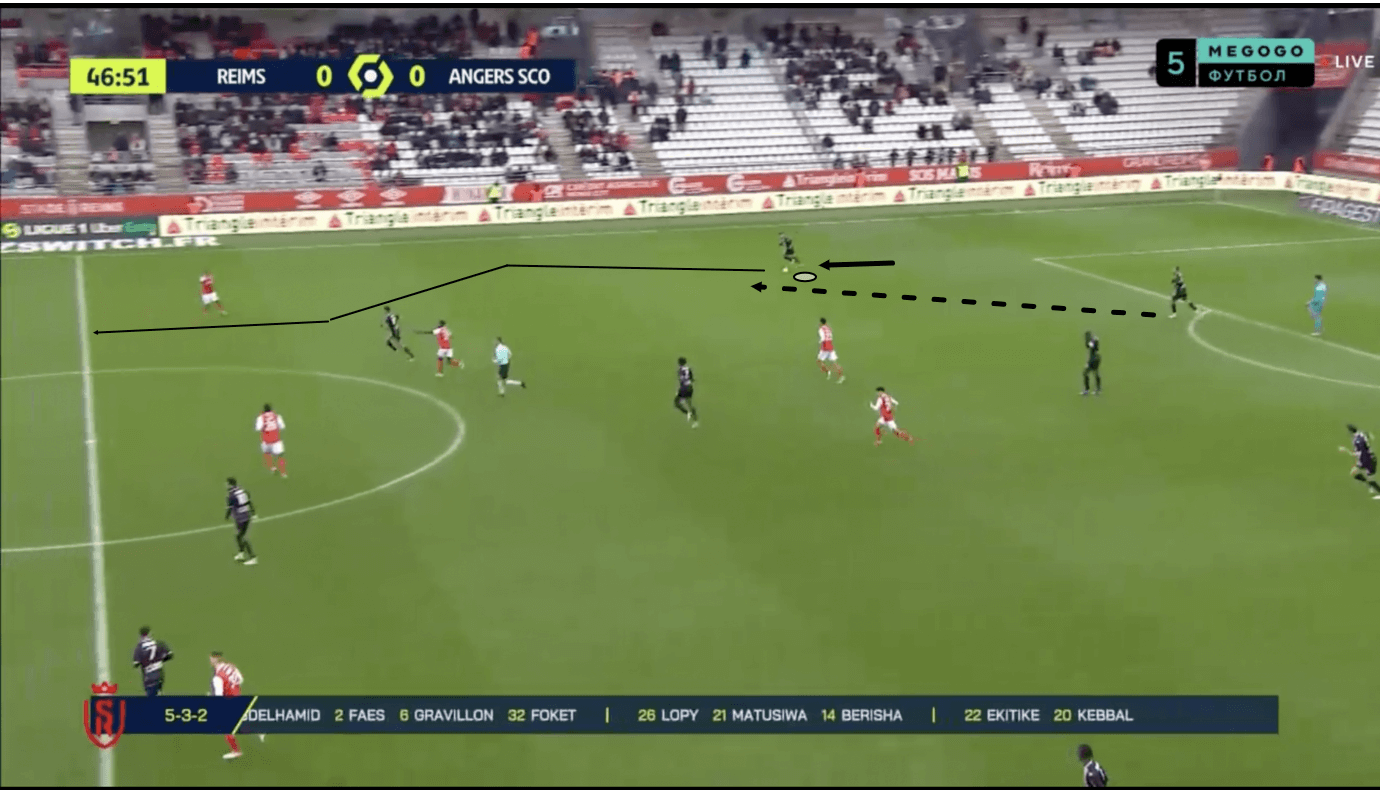
We see an example of Cabot’s progressive carrying in figures 1-2. Firstly, in figure 1, the right wing-back has just received the ball deep in his area of the pitch with his team in the build-up phase, just about to enter the progression phase.
After dropping into this position to receive the pass, Cabot had a lot of space ahead of him to drive into; the 28-year-old loves this kind of situation. We’ve marked the path that Cabot will go on to take with his carry on the image here. Initially moving wider, Cabot will draw the nearest opposition defender out before cutting inside to drive through the opposition’s midfield from a more central area.
It’s common to see Cabot carry the ball centrally and add an extra body to midfield in the progression phase. He likes to draw opposition players in via his gravity before releasing to a teammate he’ll have hopefully created more space for through his carry.
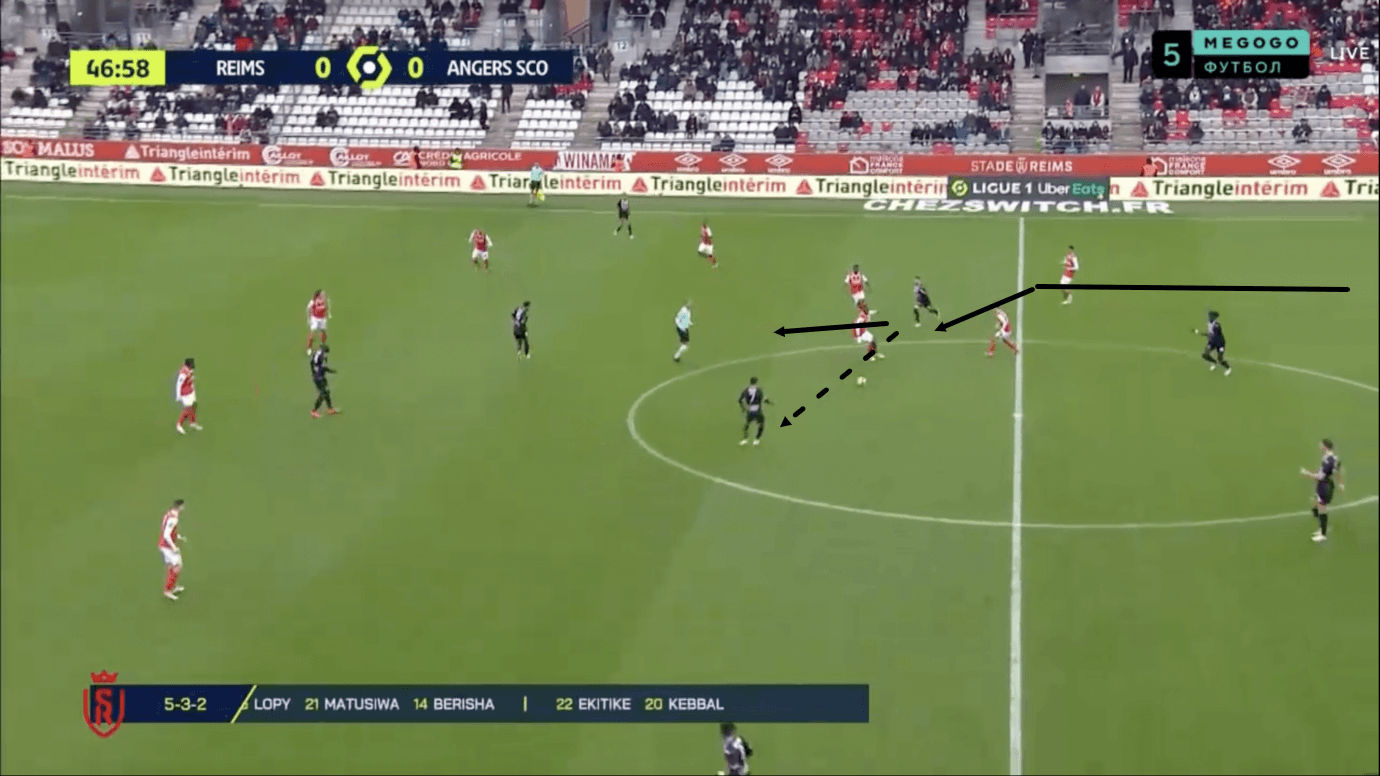
As play moves on into figure 2, we see that Cabot ends up in central midfield having breached the opposition’s first and second line of pressure. Now inside the opposition’s half and surrounded by Reims shirts, the wing-back releases to a teammate in more space to his left while continuing his forward run to provide this player with a one-two option as his team approaches the opposition’s backline.
This is just one example of Cabot’s tendency to come centrally, attract bodies towards him and look to break down the opposition through his carrying in this way. Whether or not he continues doing this at Lens will be interesting to see and will come down to how much Franck Haise believes this can be a new added benefit to the team versus how much he feels Cabot should exclusively remain wider, similar to Clauss.
He is capable of remaining wide and carrying through those areas too. However, sometimes Cabot sees the opportunity to drive centrally and takes it. This could see the wing-back receive wide for Lens and try to take the opportunity to break through the stretched opposition himself, whereas before Clauss would look to facilitate progression through a midfielder in such a situation.
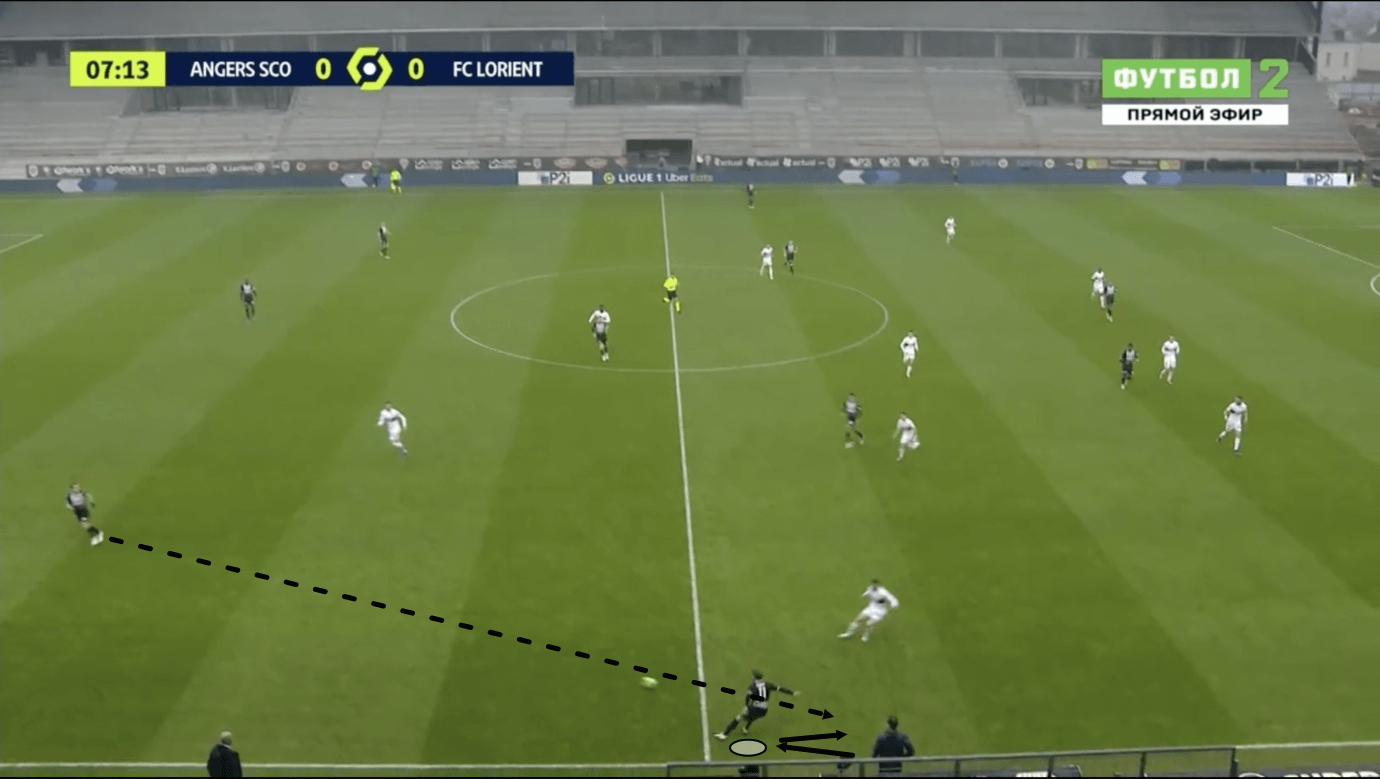
Figure 3 shows an example of Cabot receiving wide in the progression phase. Just before this image, the wing-back moved backwards a bit to create the space ahead of him for the teammate to send the ball into. At this moment, we see the wing-back turning to receive the ball on the inside of his right boot before knocking it into the space ahead of him and driving deep into the opposition’s half with it.
It’s really common to see Cabot receiving the ball on the inside of his far foot while turning on the wing before driving at the opposition like this. He’s got excellent technique when receiving and noticeably mobile hips to turn on a dime and change direction to go from facing the passer to facing the opposition backline. This can make him more difficult for the opposition defender to control.
Once Cabot is released in behind the opposition’s midfield line, as is about to happen here, he is very dangerous due to his dribbling quality and creative ability once inside the final third. As a result, the wing-back’s movement and agility to receive and turn so quickly on the wing are great assets for him and his team in terms of ball progression too.
In the final third
Both Clauss and Cabot are high-volume crossers. While Clauss did play more of his team’s crosses, on average, last season (the aforementioned 37.275% of his team’s crosses) than Cabot, the former Angers man also played a large portion (30.5%, 3.39 per 90) of his team’s crosses last term.
It’s obvious that crossing is an important skill for this particular player in Lens’ setup to have in their locker, so it was always going to be a top requirement for Clauss’ replacement to be proficient in this area. Crossing was a key component of Cabot’s role at his former club, plenty of his assists came from this skill and we expect to see this part of his game remain prominent in the final third with Lens this coming season.
Another notable area for Cabot, though, is his dribbling. Cabot completed 6.73 dribbles per 90 at Angers last season, which is 19.5% of his team’s average dribbles per 90. Meanwhile, Clauss completed just 2.65 dribbles per 90 in comparison, equalling 10.99% of his team’s average dribbles per 90 in 2021/22.
So, it’s clear that Cabot is a far more frequent dribbler than Clauss and this is something we expect to see him carry over into his performances with Lens, adding a new dynamic to Les Sang et Or’s game inside the final third next season.
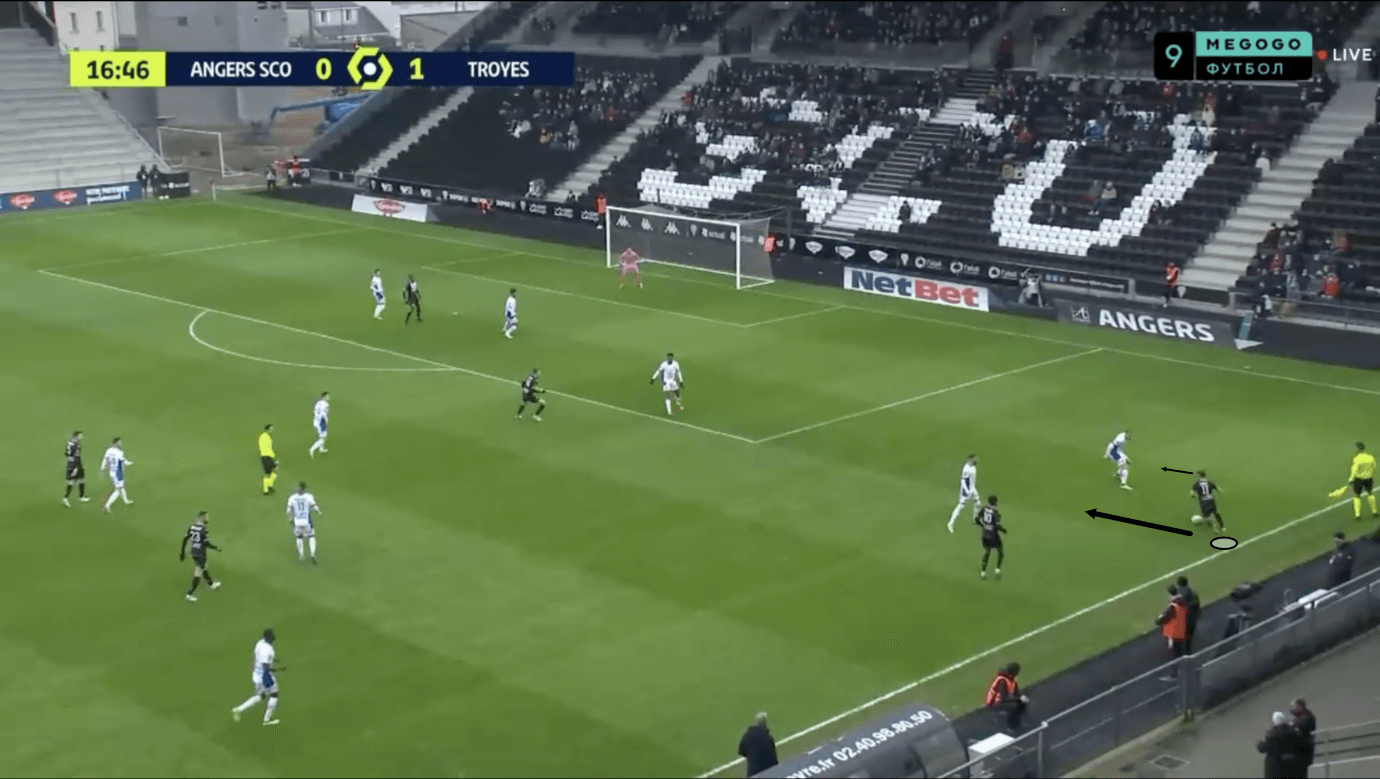
In figure 4, Cabot has just received the ball out wide on the right-wing, attracting the opposition’s left-back towards him. Cabot loves to isolate himself 1v1 versus opposition defenders in this way, as he’s confident in his dribbling ability and loves to take players on 1v1.
Here, before moving with the ball, the wing-back gets his head up briefly after receiving to assess his options and sees the vast amount of space open behind the opposition full-back, as well as the gap between the two opposition players in front of him, for the ball carrier to target.
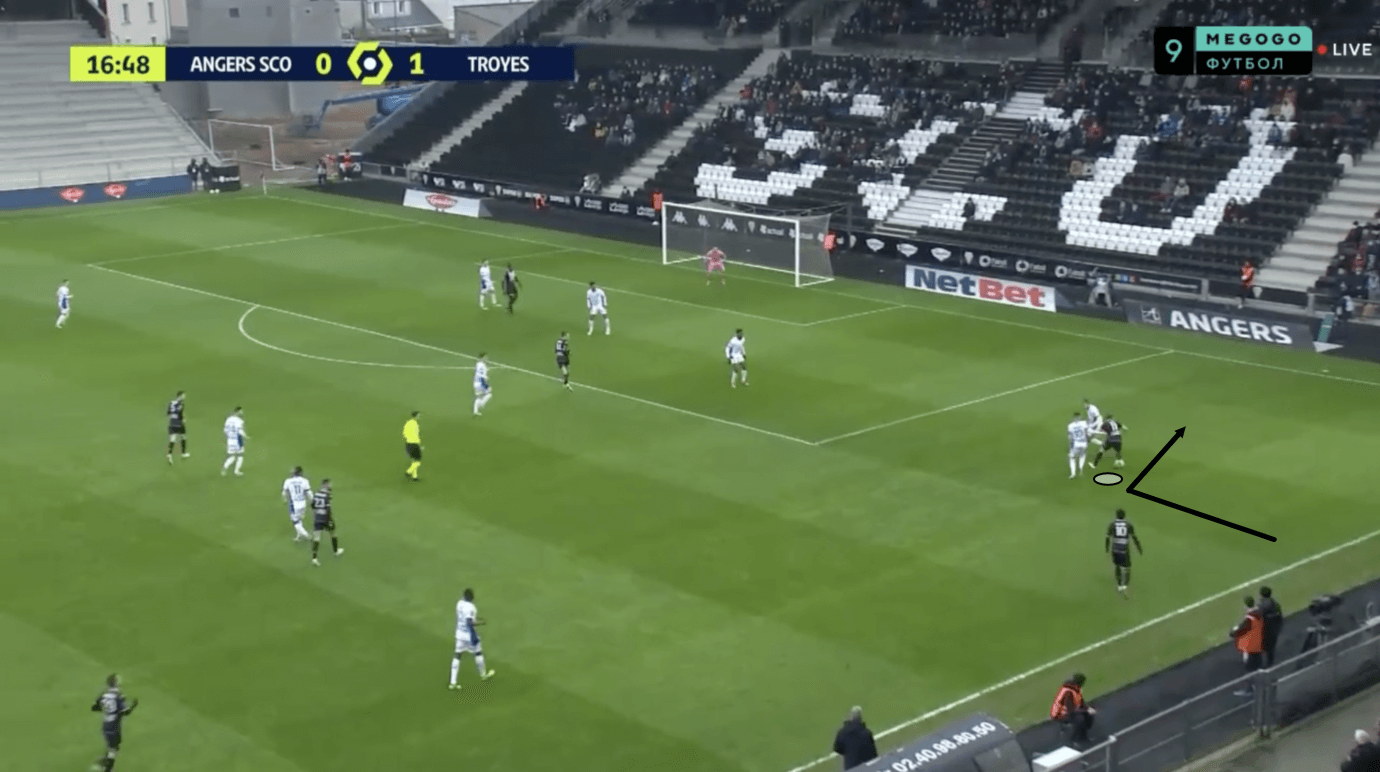
Moving on into figure 5, we see that Cabot drove straight into that gap between the two opposition players in front of him, looking to target the space behind the full-back but the two players closed in to block off the space well.
As the two opposition players blocked off the space, though, Cabot reacted excellently, showing off his ball control and agility to knock the ball to the outside of the full-back with the outside of his right boot, progressing towards the byline and setting up a crossing opportunity on his stronger right foot.
Cabot is so difficult to control when he’s running at defenders out wide, especially when 1v1 but even if the opposition have a man advantage as was the case in figure 5. He’s pacey with quick reactions, excellent ball control and great agility to turn at once, as soon as he sees the opportunity to exploit space better in a different way than where he’s currently heading.
The new Lens signing is great at moving the ball quickly between his feet and has an array of tricks in his arsenal to get past players. These are the reasons why he loves isolating himself 1v1 with defenders and creating dribbling opportunities.
As for his crossing, Cabot has a great whipped cross on him, though it isn’t uncommon to see him put far too much power on the cross, leading to the ball being sent away from danger. That’s to be expected when it comes to crossing, though, which is highly variable. Lens will be well aware of this given their reliance on crosses from wide areas from the wing-backs already.
Cabot loves to cross from the kind of position we see him progressing into in figure 5, where he can whip the ball with some height and pace, but he’s also comfortable with progressing all the way to the byline and pulling back a low cross, which is one way in which we may see him vary things up at Lens. His proficiency in dribbling will help him to progress into good positions to play these low cutback crosses from the byline.
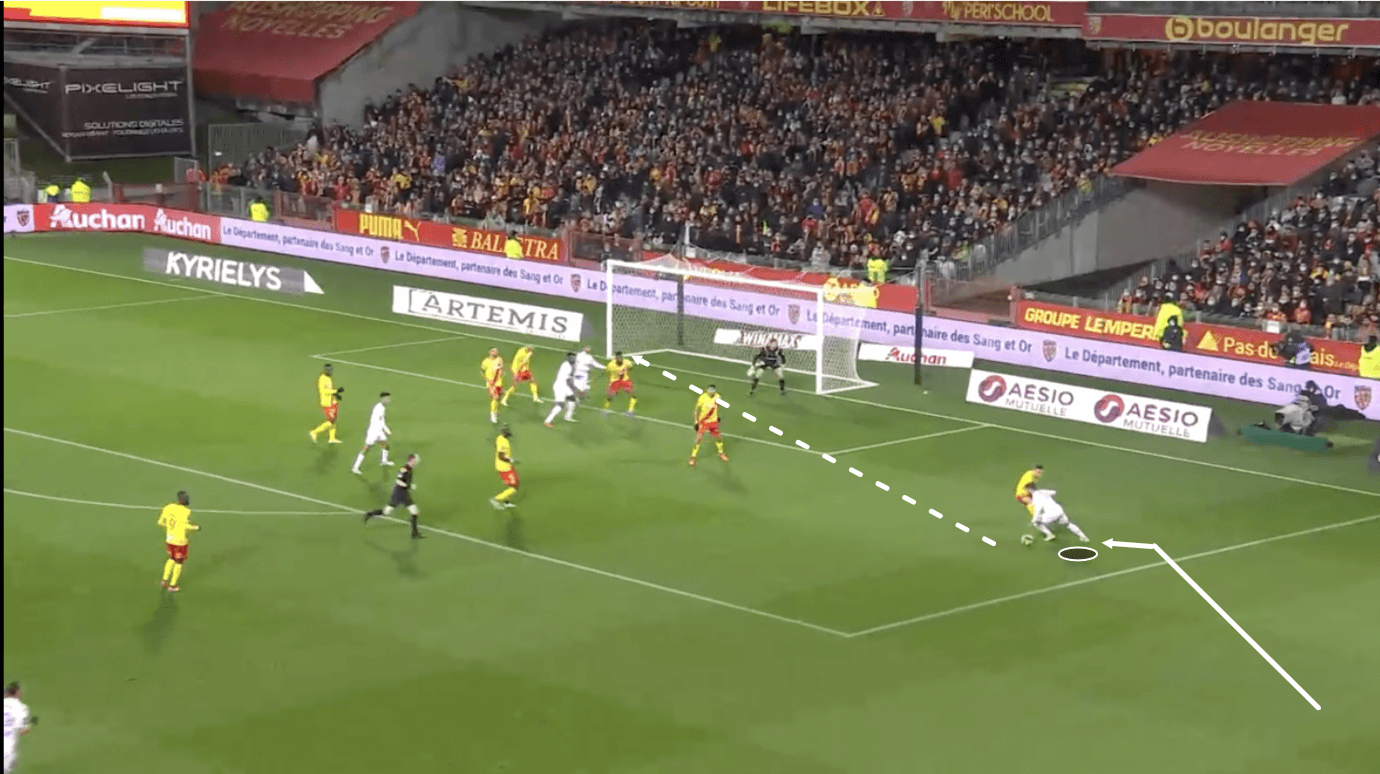
While Cabot’s right foot is undoubtedly his stronger foot, he’s not afraid to use his weaker left foot either. Granted, he doesn’t use his left an incredible amount, given he plays on the right and naturally favours playing the ball off his right foot.
However, for a right wing-back, he is quite comfortable shaking things up and cutting inside onto his left, which is something we know Lens value highly, as left wing-back Przemysław Frankowski is very two-footed and often cuts in on his right foot from the left.
Cabot doesn’t do this out of preference but sometimes the opportunity to cut inside onto his left and punish the opposition for leaving too much space is too great and we’ve seen a few examples of Cabot creating great opportunities for his team after cutting inside onto his left foot, such as the one highlighted in figure 6.
Here, Cabot has just driven towards the opposition wing-back on the right-wing. The wing-back left far too much space open on the inside, knowing that Cabot is right-footed and banking on him not being comfortable enough to cut inside onto his left from here. However, he was confident enough, as we see in figure 6. From here, we see the former Angers man play the ball into the box from his left foot, creating a goalscoring opportunity for his side.
So, teams should be careful about showing Cabot onto his weaker foot, as he’s comfortable enough with using that weapon for more than just standing. This adds yet another facet to Lens’ attacking game next season.
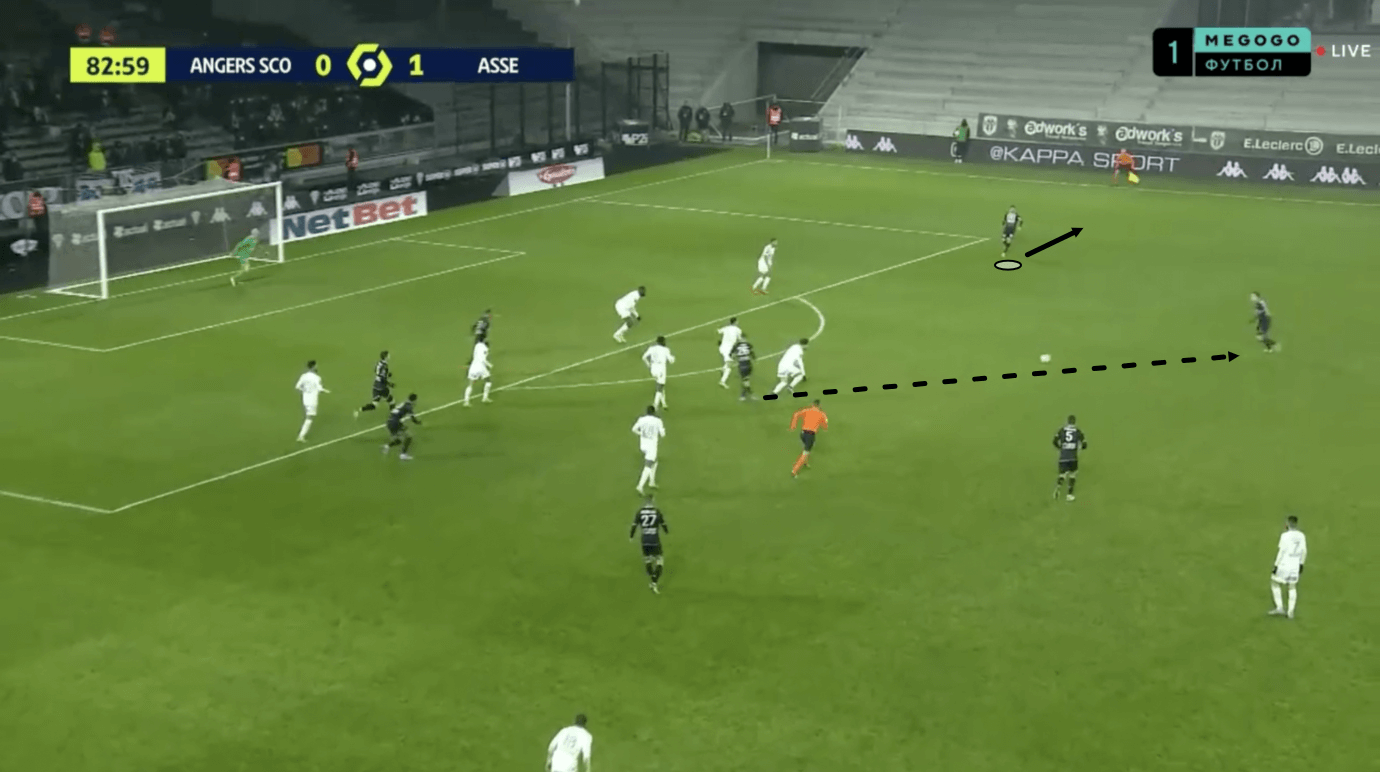
Off-the-ball movement is, of course, another important part of the wing-back’s game as a creator. When his team is parked inside the final third, in the chance creation phase looking to break the opposition down, it’s important that Cabot holds the width on the right while the opposition defence squeezes narrow to try and protect the central spaces from being penetrated. This should allow the wing-back space to work with out wide.
We see an example of this in figure 7, as Cabot begins jogging backwards to get wider as his team plays the ball around the edge of the final third.
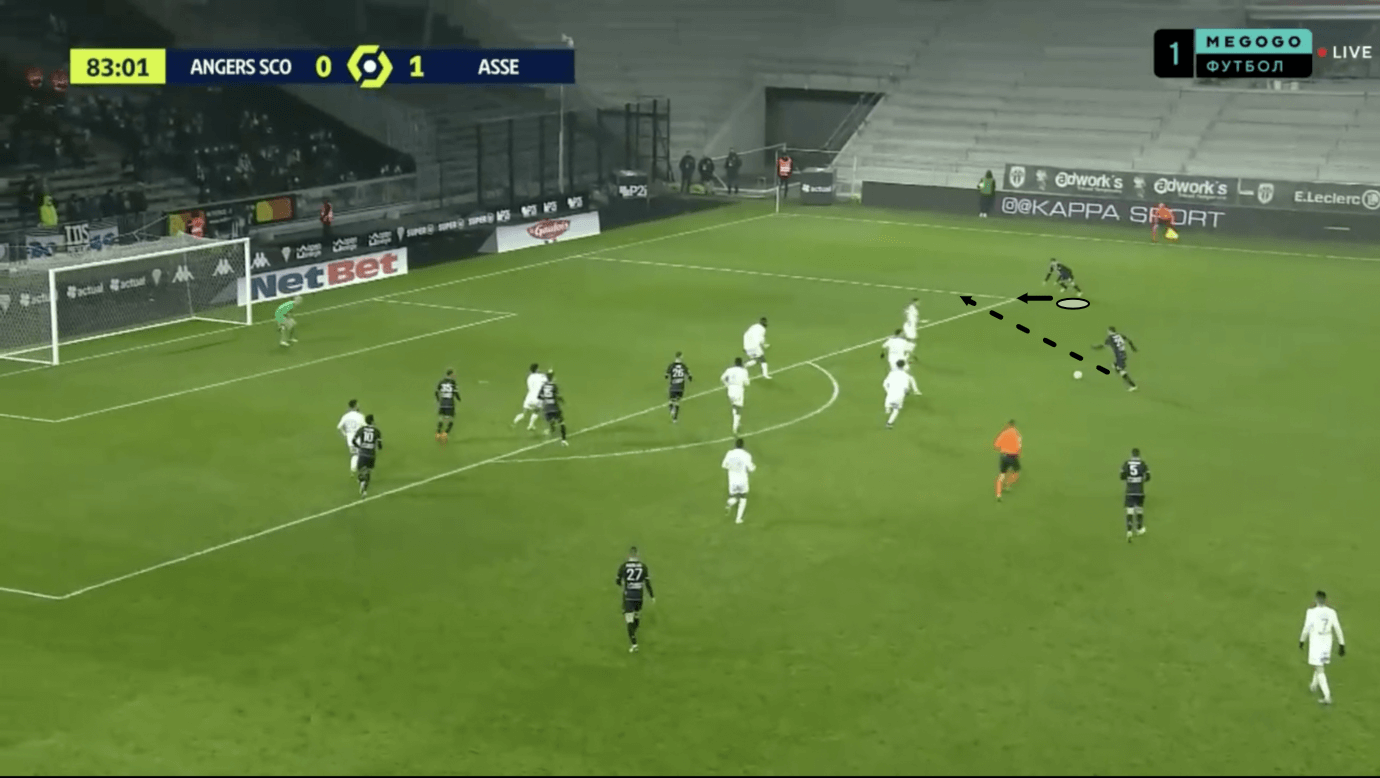
Cabot doesn’t immediately receive the through ball out wide as the right central midfielder gets on the ball, as this player intelligently carries the ball forward a few steps first, essentially creating a 2v1 overload with Cabot versus the opposition’s left-back.
Cabot has now stopped jogging backwards and started bracing himself to burst away in behind the opposition’s backline, waiting for the through ball to come, which we can see in figure 8.
By carrying the ball forward an extra few steps, Cabot’s teammate created extra space for the wing-back out wide, increasing his threat and helping him to quickly attack the space behind the opposition’s backline as the ball was played through to him. This is an example of how Cabot’s movement off the ball and timing of his runs can help his side to create great crossing opportunities from threatening, advanced positions.
Defensive qualities
As mentioned previously, aggressive defending has been a common feature of Lens’ tactics under Haise in recent seasons. Clauss competed in an average of 6.3 defensive duels per 90 (10.2% of his team’s average defensive duels per 90) last season with a 56.95% success rate while making 5.25 interceptions per 90 — the sixth-most of any Ligue 1 right-back/right wing-back and 14.22% of his team’s average interceptions per 90.
As for Cabot, then, the new Lens man-made fewer interceptions (4.4 per 90) than Clauss did last term, as well as a smaller proportion (10.65%) of his team’s interceptions than the former Lens man who’s joined Marseille. However, Cabot engaged in 9.4 defensive duels per 90 last term — 14.34% of his team’s defensive duels and the seventh-most of any Ligue 1 right-back/right wing-back with a 57.66% defensive duel success rate.
So, while Cabot made slightly fewer interceptions than Clauss last season, he engaged in far more defensive duels with a slightly better defensive duel success rate.
Interceptions are an important aspect of Lens’ defensive tactics, in all honesty, and they won’t want to massively compromise in this area as it has a knock-on effect to their attacking game. As our previous analysis article on Lens’ wing-backs demonstrated, Les Sang et Or rely on their counterattacks to an extent and like to capitalise on transitional moments.
Interceptions from the wing-backs who are given licence to act aggressively and pounce on chances to cut out the ball when they appear are important for creating counter-attack opportunities to hit the opposition’s backline when they aren’t prepared very well to defend against them.
Cabot will need to be alert and ready to pounce on such opportunities when they appear and perhaps up his game in terms of aggressively pursuing interceptions a small bit. With that said, he didn’t make far fewer interceptions than Clauss last season and is good at reading the game, as figures 9-10 show.
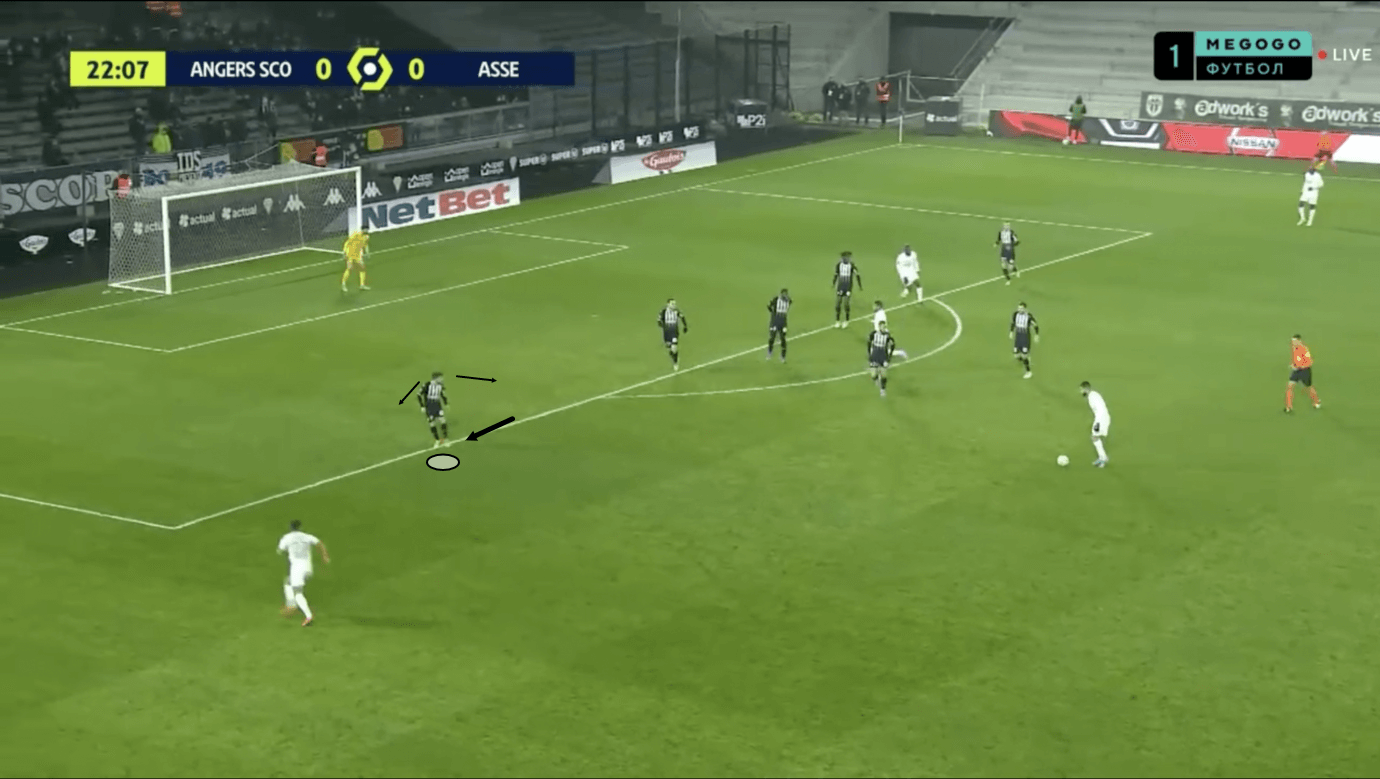
Firstly, figure 9 shows Cabot positioning himself very well in the passing lane between the ball carrier and the runner targeting space behind Angers’ backline. The right wing-back demonstrated great spatial awareness just before this image, checking his shoulder for the runner’s movement while keeping an eye on the passer and his intent as well. This helped the wing-back to position himself in an optimal way to stall the attack.
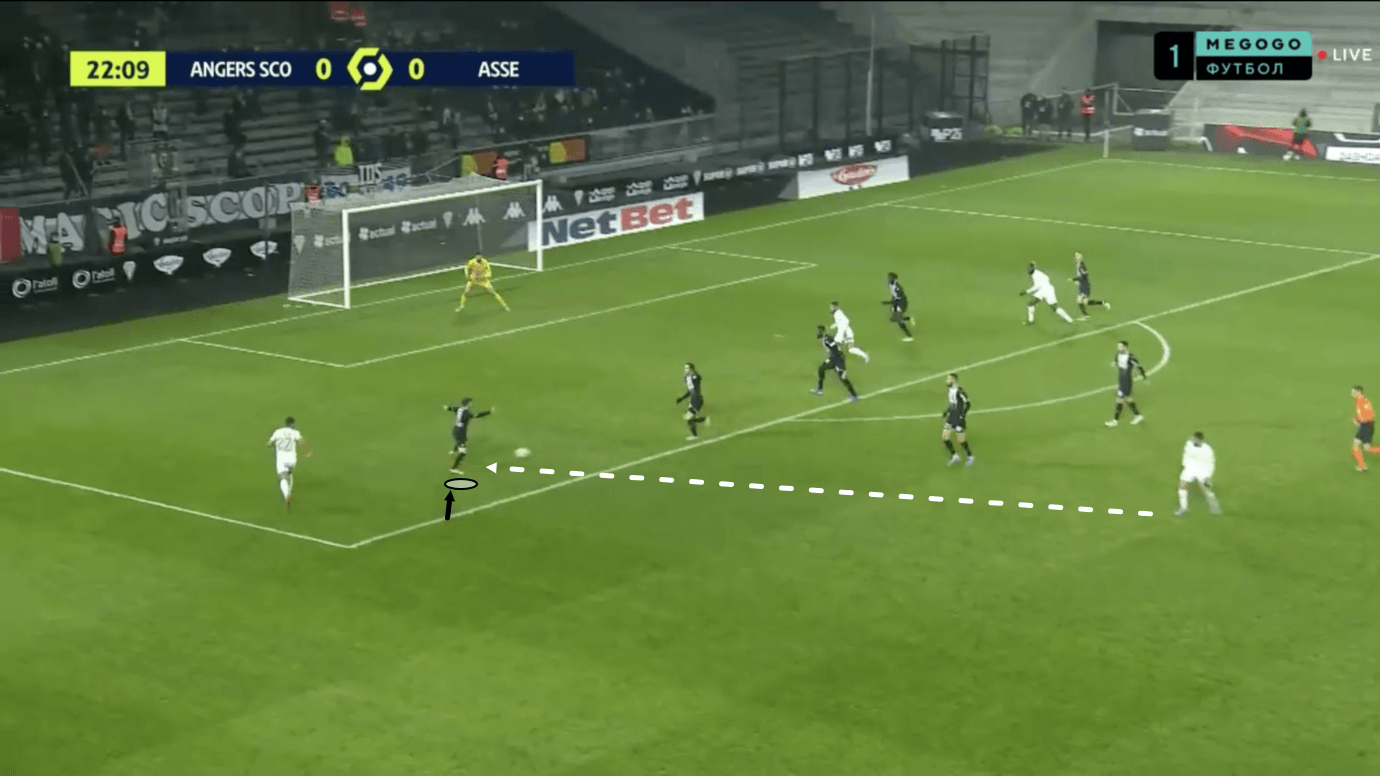
As play moves on into figure 10, we can see that the ball carrier was ultimately pressured into playing the pass, with the runner just about to enter an offside position had the ball not been played right there and then.
The passer attempted to split Angers’ defence with the through ball, targeting space between Cabot and the right centre-back with his drive. However, that ball came to no avail as Cabot had already positioned himself very well and then reacted to the pass excellently, cutting it out and putting an end to this attacking move. From here, the wing-back could kickstart a counter-attack opportunity for his side.
Expect to see Cabot pick off balls like this and then start driving forward into space himself, aiming to attract opposition bodies towards him and exploit space elsewhere on the counterattack when the opportunity arises.
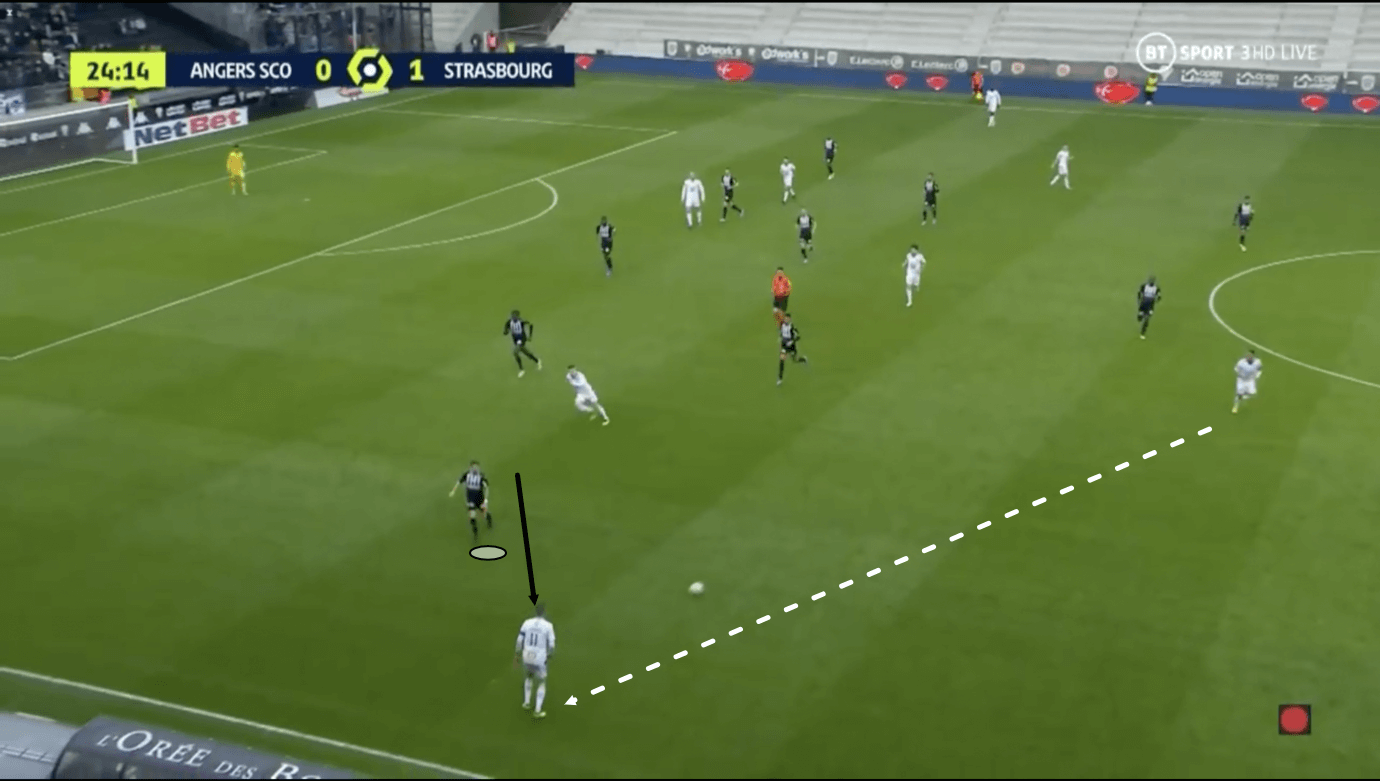
Cabot is quick and aggressive about engaging opposition attackers as the ball is played to them. It doesn’t take him long to get out to players and immediately deny them much space to play with. At the same time, the 28-year-old doesn’t just dive into challenges carelessly, without paying attention to what’s going on around him and generally ensures that he maintains a healthy distance, covering the necessary passing lanes while closing the receiver down.
We see an example of Cabot closing down the receiver on the left wing here while a runner sees this as an opportunity to move from in-to-out behind the right wing-back, aiming to exploit the newly-opened space behind Cabot, in figure 11.
As play moves on from here, Cabot ensures the passing lane is covered while he closes down the receiver, demonstrating excellent spatial awareness. As the receiver here in figure 11 sends the through ball in behind for the runner to chase, Cabot steps across the passing lane and cuts the ball out, regaining possession for his side and definitively putting a stop to this attack.
So, while Cabot is aggressive and likes to engage attackers a lot, he’s also got a very good ability to read the game and cut out passes without needing to get physical all the time. Still, it’s very common to see Cabot get physical and this is a part of his game in which he thrives.
While the right wing-back isn’t extremely physically imposing, he’s very comfortable getting his short but wide frame between the opposition player and the ball and holding them off to protect the ball in this way. So, don’t take Cabot’s lack of size for a lack of physicality — he’s proficient in this area of the game.
Conclusion
To conclude this tactical analysis and scout report, we feel that Cabot is a great bit of transfer business from Lens and provided that he recovers from his ankle injury adequately, he should be able to slot into Clauss’ old spot within Haise’s system without much of a drop-off in quality.
There will surely be a period of settling in for the new wing-back, however, as the wing-back position is crucial to Lens’ system and Cabot has some clear stylistic differences from his predecessor in this role. However, broadly speaking, he’s another creative wing-back who’s comfortable on the ball and defending aggressively and who should provide a great creative threat for Les Sang et Or within the final third.
Considering that he cost Lens far less than they reportedly received for Clauss, this move seems a no-brainer for us, especially as Clauss himself may struggle to kick on from his achievements at Lens in a completely new environment, now that he’s not playing in a system tailored for creative output from the wing-backs.





Comments